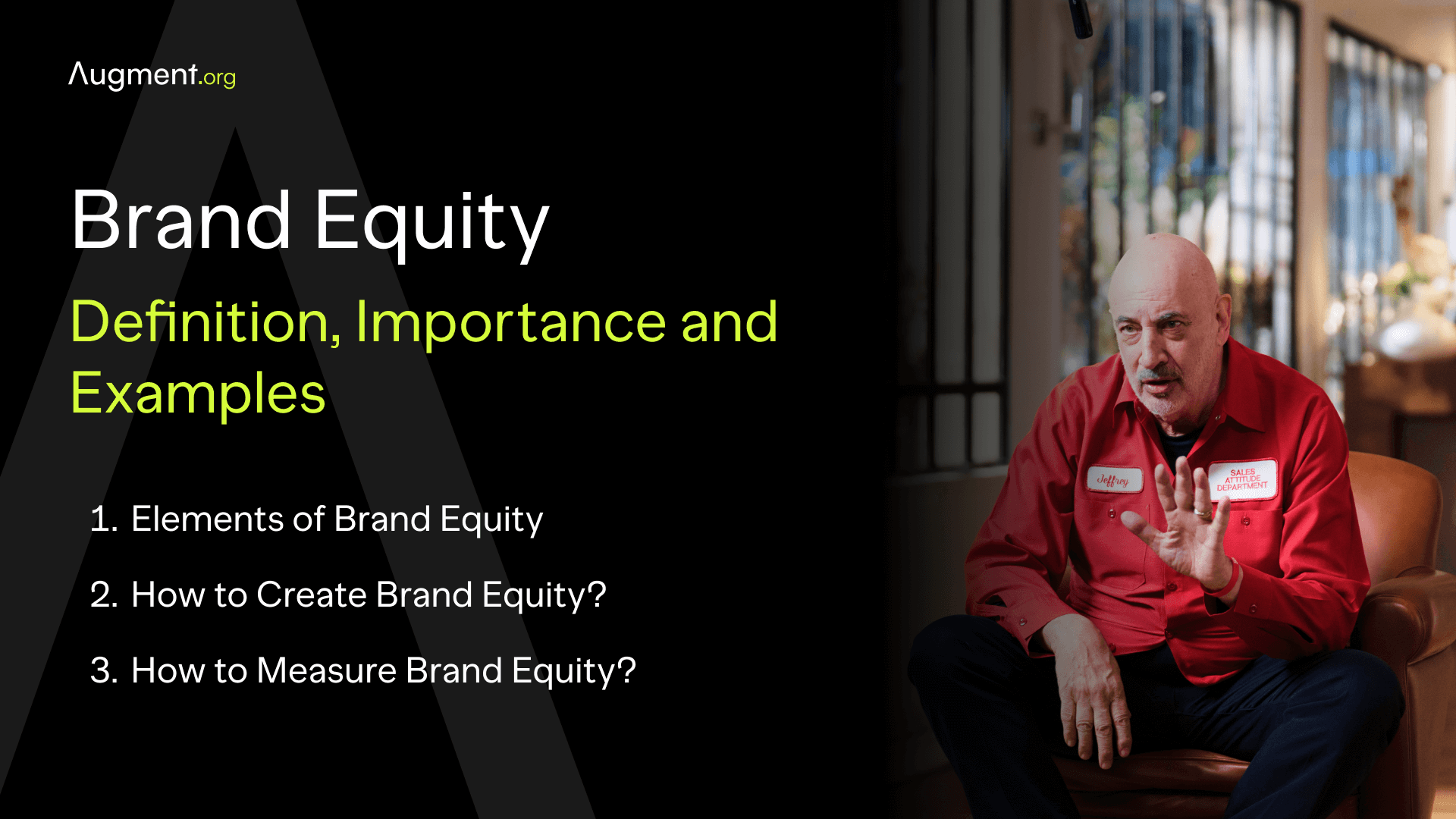Brand Equity: Definition, Importance, and Examples
Building brand equity turns customer loyalty into a business asset. Discover how strong reputation and customer perceptions drive performance, creating a trusted brand that commands premium prices and fosters loyalty.

What is Brand Equity?
Brand equity refers to the value a brand adds to a product or service. It's the difference between a generic item and one with a recognizable name, where the name itself carries weight. This concept rests on consumer perceptions, including brand awareness, associations, and loyalty. Strong brand equity means customers think highly of the brand, often leading to repeat purchases and customer loyalty.
Essentially, it's the brand's reputation in the marketplace and a key driver in a company's success. High brand equity contributes to a company's overall health, affecting everything from profit margins to brand visibility and customer preference.
Why Does Brand Equity Matter?
Brand equity matters significantly in today’s competitive market. It's not just about having a solid brand image. High brand equity means a company can charge a price premium, reflecting the perceived quality and brand value in the eyes of customers. This isn't just beneficial for profit margins; it's crucial for long-term business performance.
Positive brand equity builds customer loyalty, attracting new customers while retaining existing ones. It's the cornerstone of a strong brand identity, fostering positive customer feelings and associations. Brands with high equity are often seen as symbols of trust and reliability, influencing consumer choices and preferences.
In essence, brand equity connects deeply with consumer perception, impacting everything from social media engagement to repeat purchases. It's not just about the products a brand offers but how customers perceive and value these offerings. Understanding and managing brand equity is thus vital for any business aiming to maintain a strong, healthy brand in a competitive landscape.
Brand Equity vs Brand Awareness
Brand equity and brand awareness are both vital, but they focus on different aspects of a brand's relationship with its audience. Brand awareness is about how familiar people are with a brand. It's the extent to which consumers can recognize or recall a brand under different conditions. This is the first step in building a relationship with the market. The more people know of a brand, the more likely they are to consider it when making purchase decisions.
On the other hand, brand equity looks deeper into the quality of this relationship. It's not just recognizing the brand but having a strong, positive association with it. Brand equity encompasses elements like customer loyalty, perceived value, and brand associations. It's the outcome of consistent positive experiences and perceptions of the brand. While brand awareness can be seen as the breadth of a brand's influence, brand equity is about the depth and quality of that influence.
Brand awareness sets the stage for building brand equity. A well-known brand isn't necessarily a beloved one, but it's hard for a brand to be beloved if it's not well-known. Managing both aspects effectively leads to a strong brand that resonates with customers and stands out in the market.
Elements of Brand Equity
The elements of brand equity are the building blocks that create a strong and valuable brand in the eyes of consumers. These include:
- Brand Loyalty: This is the commitment of customers to continue buying from a brand, often reflected in repeat purchases and recommendations to others. Brand loyalty means that customers prefer your brand over competitors, even sometimes paying a higher price.
- Brand Awareness: This refers to how familiar people are with a brand. High brand awareness means that the brand is easily recognized and recalled by potential customers. It's the first step in creating a relationship with the market.
- Perceived Quality: This is the customer's perception of the overall quality or superiority of a product or service. Even if two products are identical, perceived quality can make one brand more desirable than the other due to its reputation.
- Brand Associations: These are the attributes, positives or negatives, that customers think of when they consider a brand. These can include product characteristics, user experiences, or other symbolic elements like logos or slogans.
- Brand Assets: These include the tangible and intangible elements that add value to the brand, like trademarks, proprietary technology, or a highly skilled workforce. Brand assets make a brand unique and valuable.
Each of these elements contributes to the brand's equity. When managed effectively, they enhance a brand's reputation, create customer loyalty, and can lead to higher profit margins and market share. Building strong brand equity is about ensuring that these elements work together to create a positive and lasting impression in the minds of consumers.
How to Create Brand Equity
Creating brand equity is a strategic process that involves understanding and influencing customer perception. Here are steps to build brand equity:
- Define Your Brand Identity: Clearly define what your brand stands for, its values, and its unique selling proposition. A strong brand identity helps customers understand what you offer and why it's different from competitors.
- Consistent Brand Messaging: Ensure that all communications, from advertising to customer service, consistently reflect the brand's identity and values. Consistency helps build recognition and trust over time.
- Quality Products and Services: Offer high-quality products and services that meet or exceed customer expectations. Perceived quality is a crucial component of brand equity.
- Customer Experience: Provide excellent customer service and a positive overall experience with the brand. Happy customers are more likely to become loyal advocates and spread positive word of mouth.
- Build Brand Awareness: Invest in marketing strategies that increase brand visibility and recognition. The more familiar people are with your brand, the more likely they will consider it when making purchase decisions.
- Foster Brand Loyalty: Encourage repeat business and customer loyalty through rewards, consistent quality, and engagement. Loyal customers can boost brand equity significantly.
- Monitor and Adapt: Keep an eye on consumer preferences, market trends, and the competitive landscape. Be ready to adapt strategies as needed to maintain and grow brand equity.
By focusing on these areas, you can build positive brand equity, leading to a brand that is highly regarded, trusted, and preferred by customers. This not only helps attract and retain customers but can also allow for premium pricing, better customer engagement, and overall healthier brand performance.
How to Measure Brand Equity
Measuring brand equity is key to understanding its impact on your business. Here are common methods to assess the strength and value of brand equity:
- Brand Recognition and Recall: This measures how well customers can recognize and recall the brand. Surveys and questionnaires can assess how easily people recognize brand logos, taglines, or products.
- Customer Surveys and Feedback: Conduct surveys to understand customer perceptions of the brand's quality, associations, loyalty, and overall satisfaction. This can provide insight into the brand's strengths and areas for improvement.
- Market Share Analysis: Comparing your brand's market share to competitors can indicate your brand's relative strength in the industry. Higher market share can suggest stronger brand equity.
- Financial Metrics: Evaluate financial data like profit margins, price premiums compared to competitors, and overall revenue growth. These indicators can show the financial benefit of having strong brand equity.
- Customer Loyalty and Retention: Measure repeat purchase rates and the length of customer relationships. Loyal customers who make frequent repeat purchases are signs of positive brand equity.
- Social Media and Online Engagement: Analyze social media mentions, sentiment, and engagement rates. High levels of positive online engagement can be indicative of strong brand equity.
By using these methods, businesses can get a comprehensive understanding of their brand equity and how it's affecting customer behavior and business outcomes. Measuring brand equity is an ongoing process, and the insights gained should guide strategies for maintaining and enhancing the brand's position in the market.
Brand Equity Examples
Brand equity is best understood through real-world examples. Here are a few brands known for their strong brand equity:
- Apple: Known for innovation and quality, Apple has strong brand equity. Customers associate it with cutting-edge technology and design, leading to customer loyalty and the ability to charge higher prices.
- Coca-Cola: With its iconic branding and global recognition, Coca-Cola enjoys high brand equity. Its brand is associated with happiness and nostalgia, helping it maintain market leadership.
- Nike: Nike represents more than just athletic apparel; it symbolizes motivation and performance. Its "Just Do It" slogan and swoosh logo are globally recognized, contributing to its strong brand equity.
- McDonald's: McDonald's golden arches and consistent product quality across the world have helped it achieve high brand recognition and loyalty. Its brand represents quick, reliable food options, enhancing its brand equity.
- Amazon: Known for its vast selection and customer-centric approach, Amazon has built strong brand equity. Its reputation for convenience and innovation makes it a go-to for a wide range of products.
These brands have successfully managed their brand elements, from logos and slogans to product quality and customer service, to build positive associations and loyalty. Their strong brand equity helps them attract and retain customers, command higher prices, and maintain a competitive edge. Each of these examples demonstrates how powerful brand equity can be in driving business success.



